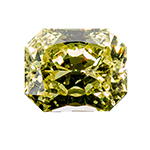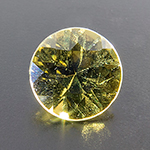Chrysoberyl
A relatively rare beryllium-aluminium-oxide.

Fine chrysoberyl from Brazil
Origin of name: from Greek χρυσός [chrysós] „gold“ and βήρυλλος [beryllos]. In ancient times the word "beryl" was used to describe many golden yellow gems.
Synonyms and trade names: none. Chrysoberyl cat´s eyes are also known as cymophan. The colourchanging variety is alexandrite.
Can be confused with: many other yellow and greenish yellow gems. Identification usually is no big deal for gemmologists.
Chrysoberyl cat´s eyes may be confused with (much cheaper) quartz cat´s eyes.
Alexandrite can be confused with other colourchanging gems like sapphire, garnet, spinel (very rare!), synthetic alexandrite and synthetic colour-change corundum.
To our knowledge (as of Jan. 2021) there is no synthetic yellow chrysoberyl.
Localities: most important sources are Brazil, India (Orissa), Sri Lanky, Mynmar (Burma) and Madagscar.

Chrysoberyl from Sri Lanka
Handling: Mohs hardness of 8.5 and resistance to acids make chrysoberyl a first class gem stone. However, cleavage is distinct in one direction so, do be careful during setting. Sensitive to heat. Unset before soldering. Do not cover in Borax!
 Deutsch
Deutsch